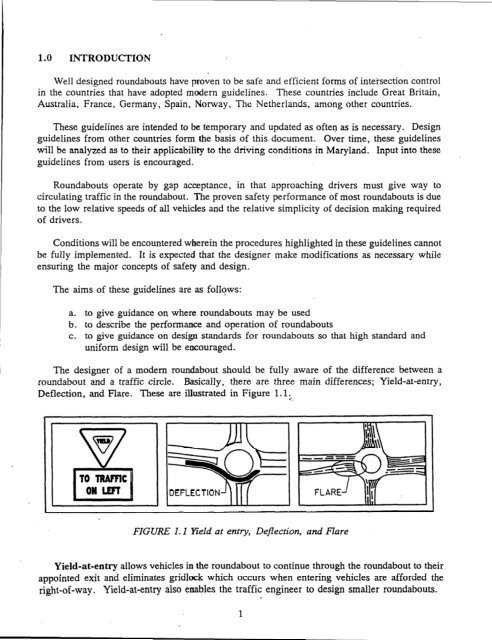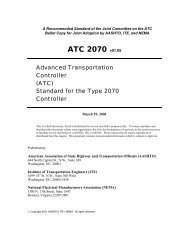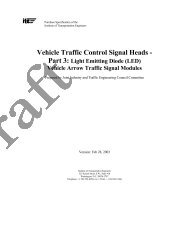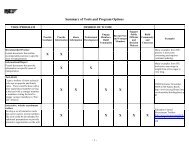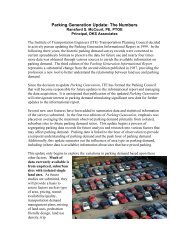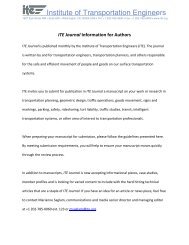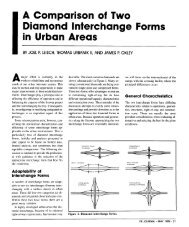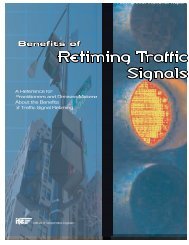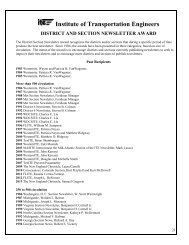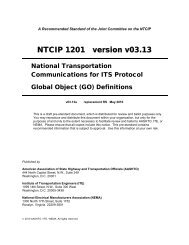roundabout ~' ~ design guidelines - Institute of Transportation ...
roundabout ~' ~ design guidelines - Institute of Transportation ...
roundabout ~' ~ design guidelines - Institute of Transportation ...
You also want an ePaper? Increase the reach of your titles
YUMPU automatically turns print PDFs into web optimized ePapers that Google loves.
1.0 INTRODUCTION<br />
Well <strong>design</strong>ed <strong>roundabout</strong>s have proven to be safe and efficient forms <strong>of</strong> inteisection control<br />
in the countries that have adopted modern <strong>guidelines</strong>. These countries include Great Britain,<br />
Australia, France, Germany, Spain, Norway, The Netherlands, among other countries.<br />
These <strong>guidelines</strong> are intended to be temporary and updated as <strong>of</strong>teq as is necessary. Design<br />
<strong>guidelines</strong> from other countries form the basis <strong>of</strong> this document. Over time, these <strong>guidelines</strong><br />
will be analyzed as to their applicability to the driving conditions in Maryland. Input into these<br />
<strong>guidelines</strong> from users is encouraged.<br />
Roundabouts operate by gap acceptance, in that approaching drivers must give way to<br />
circulating traffic in the <strong>roundabout</strong>. The proven safety performance <strong>of</strong> most <strong>roundabout</strong>s is due<br />
to the low relative speeds <strong>of</strong> all vehicles and the relative simplicity <strong>of</strong> decision making required<br />
<strong>of</strong> drivers.<br />
Conditions will be encountered wherein the procedures highlighted in these <strong>guidelines</strong> cannot<br />
be fully implemented. It is expected that the <strong>design</strong>er make modifications as necessary while<br />
ensuring the major concepts <strong>of</strong> safety and <strong>design</strong>.<br />
The aims <strong>of</strong> these <strong>guidelines</strong> are as follqws:<br />
a. to give guidance on where <strong>roundabout</strong>s may be used<br />
b. to describe the performance and operation <strong>of</strong> <strong>roundabout</strong>s<br />
C. to give guidance on <strong>design</strong> standards for <strong>roundabout</strong>s so that high standard and<br />
uniform <strong>design</strong> will be encouraged.<br />
The <strong>design</strong>er <strong>of</strong> a modem <strong>roundabout</strong> should be fully aware <strong>of</strong> the difference between a<br />
<strong>roundabout</strong> and a traffic circle. Basically, there are three main differences; Yield-at-entry,<br />
Deflection, and Flare. These are illustrated in Figure 1.1. .‘.<br />
FIGURE 1.1 YieId at entry, Deflection, and Flare<br />
Yield-at-entry allows vehicles in the <strong>roundabout</strong> to continue through the <strong>roundabout</strong> to their<br />
appointed exit and. eliminates gridiock which occurs when entering vehicles are afforded the<br />
right-<strong>of</strong>-way. Yield-at-entry also enables the traffic engineer to <strong>design</strong> smaller <strong>roundabout</strong>s.<br />
1


